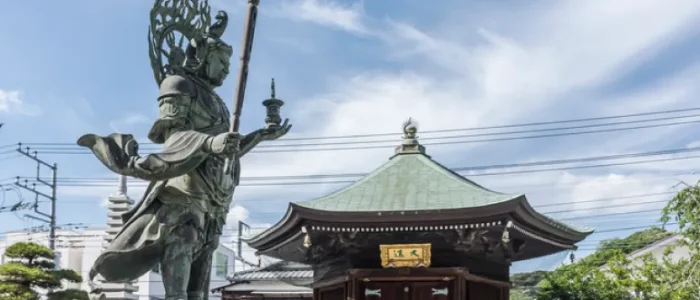Chosho-ji Temple (長勝寺)
Discover the Chosho-ji Temple (長勝寺)
Chosho-ji Temple is a historic Nichiren Buddhist temple founded in the mid-13th century during the Kamakura period. Its origin traces back to when Saint Nichiren (日蓮) built a humble thatched hermitage in the Matsubagayatsu (松葉ヶ谷) area of Kamakura. Deeply moved by Nichiren’s teachings, local lord Ishii Nagakatsu (石井長勝) offered part of his estate to support the monk’s practice. This site became the location of Honkoku-ji Temple (本圀寺), which later moved to Kyoto. On the original site, the temple was reconstructed in the mid-14th century and renamed Chosho-ji Temple in honor of Ishii Nagakatsu (石井長勝).
When Is the Best Time to Visit?
Late March to early April is the best season to see the temple’s cherry blossoms, including weeping sakura and Somei Yoshino varieties. In autumn, golden ginkgo leaves create a picturesque scene across the grounds. Early morning is especially tranquil. Guests staying at Tosh’s Place (トシズプレイス) can enjoy a calm stroll before or after breakfast, making the most of their flexible travel schedule.
Photo Highlights and Must-See Spots
One of the architectural highlights is the Hokkedo Hall (法華堂), built in the late Muromachi period. It features a five-bay facade with six wooden columns and is designated as a cultural property of Kanagawa Prefecture.
As visitors walk up the approach, they’ll encounter a towering 8-meter statue of Nichiren and imposing statues of the Four Heavenly Kings—Jikokuten (持国天), Zōjōten (増長天), Kōmokuten (広目天), and Bishamonten (毘沙門天)—guarding the path to the main hall. The seasonal contrast between ancient sculptures and blooming trees creates a deeply memorable atmosphere.
Behind the main hall, the Rokkakudo (六角堂) enshrines what is said to be a relic of Nichiren’s tooth. A wooden plaque above the entrance reads “Kuon” (久遠), referring to the eternal nature of the Lotus Sutra. This space provides visitors with spiritual solace and a place for quiet prayer.
Embrace the Quiet Hours of Morning
Because of its slightly remote location, Chosho-ji Temple remains peaceful even during peak seasons. Early morning visits are highly recommended. For travelers staying at Tosh’s Place (トシズプレイス), the temple is within walking distance, making it an ideal destination for an early stroll before the day’s main activities. The silence, combined with the rich history, offers a moment of reflection beyond typical sightseeing.
How to Get There from Tosh’s Place (トシズプレイス)
The temple is open from 9:00 AM to 4:00 PM. From Kamakura Station (鎌倉駅) East Exit, take a bus to the “Chosho-ji” stop, then walk for about one minute. Alternatively, it is accessible from Wadazuka Station (和田塚駅). Though slightly removed from the main tourist routes, this detour ensures a calm, contemplative atmosphere for visitors. The walking route from Tosh’s Place (トシズプレイス) adds a sense of quiet discovery, turning the journey itself into part of the experience.
Wrap-Up: Chosho-ji Temple and a Local Way to Experience Kamakura
Chosho-ji Temple is not just a religious site but a space where history, nature, and legend intertwine. From its origin linked to Saint Nichiren to the striking Hokkedo Hall (法華堂) and the spiritual Rokkakudo (六角堂), every corner invites reflection. In spring and autumn, the temple grounds burst with color, while the year-round tranquility offers a stark contrast to busier Kamakura (鎌倉) destinations. Especially for those enjoying a flexible, kitchen-equipped stay at Tosh’s Place (トシズプレイス), a visit to Chosho-ji offers an authentic, unhurried way to connect with Kamakura’s quieter side.ites you to slow down and reflect. If you’re staying nearby, don’t miss the chance to visit in the quiet hours of the morning—it’s a moment of peace that lingers long after.

